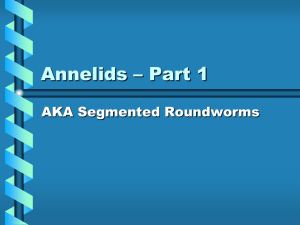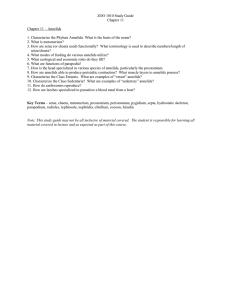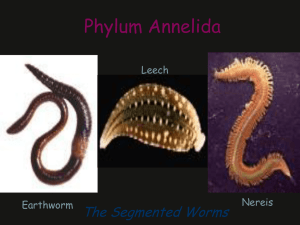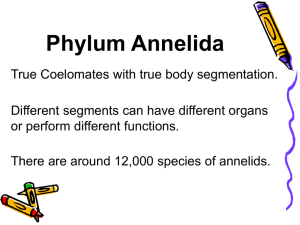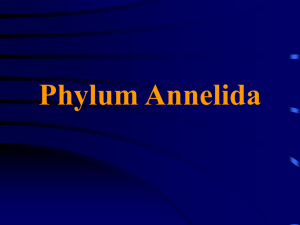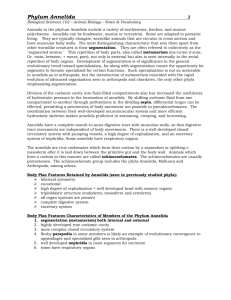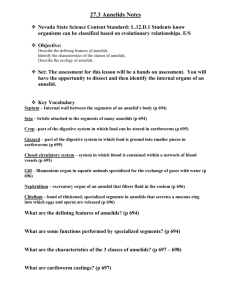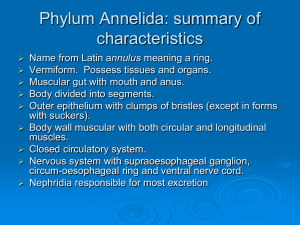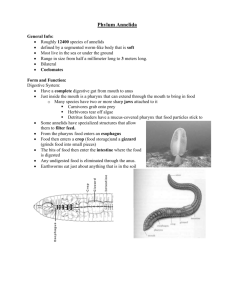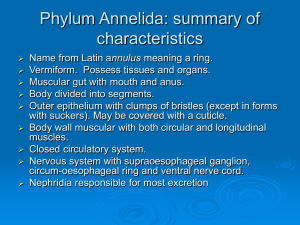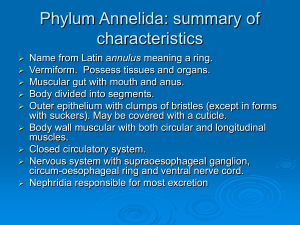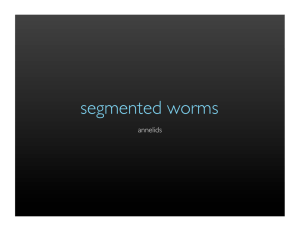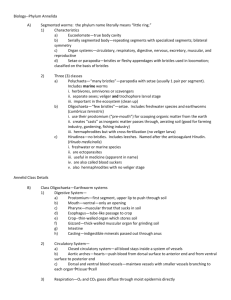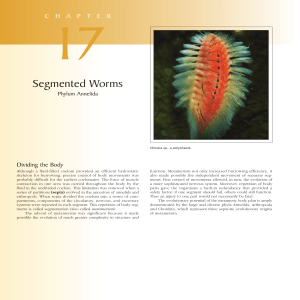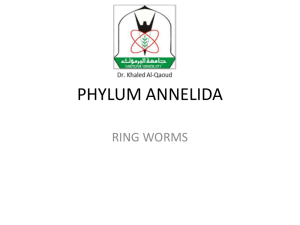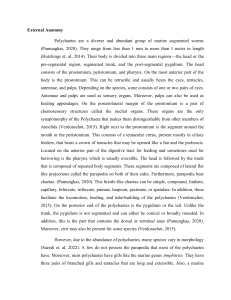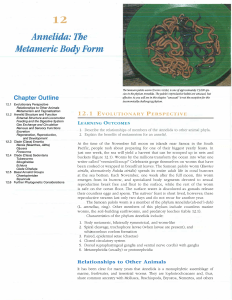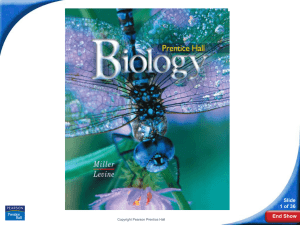Phylum Annelida
advertisement
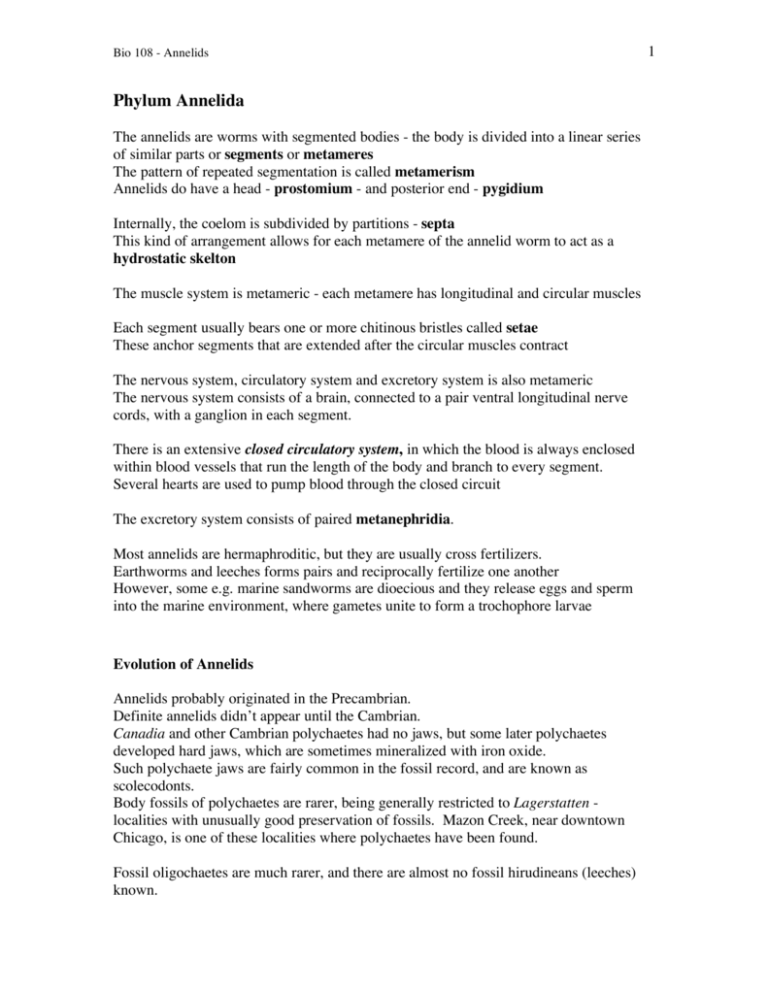
Bio 108 - Annelids Phylum Annelida The annelids are worms with segmented bodies - the body is divided into a linear series of similar parts or segments or metameres The pattern of repeated segmentation is called metamerism Annelids do have a head - prostomium - and posterior end - pygidium Internally, the coelom is subdivided by partitions - septa This kind of arrangement allows for each metamere of the annelid worm to act as a hydrostatic skelton The muscle system is metameric - each metamere has longitudinal and circular muscles Each segment usually bears one or more chitinous bristles called setae These anchor segments that are extended after the circular muscles contract The nervous system, circulatory system and excretory system is also metameric The nervous system consists of a brain, connected to a pair ventral longitudinal nerve cords, with a ganglion in each segment. There is an extensive closed circulatory system, in which the blood is always enclosed within blood vessels that run the length of the body and branch to every segment. Several hearts are used to pump blood through the closed circuit The excretory system consists of paired metanephridia. Most annelids are hermaphroditic, but they are usually cross fertilizers. Earthworms and leeches forms pairs and reciprocally fertilize one another However, some e.g. marine sandworms are dioecious and they release eggs and sperm into the marine environment, where gametes unite to form a trochophore larvae Evolution of Annelids Annelids probably originated in the Precambrian. Definite annelids didn’t appear until the Cambrian. Canadia and other Cambrian polychaetes had no jaws, but some later polychaetes developed hard jaws, which are sometimes mineralized with iron oxide. Such polychaete jaws are fairly common in the fossil record, and are known as scolecodonts. Body fossils of polychaetes are rarer, being generally restricted to Lagerstatten localities with unusually good preservation of fossils. Mazon Creek, near downtown Chicago, is one of these localities where polychaetes have been found. Fossil oligochaetes are much rarer, and there are almost no fossil hirudineans (leeches) known. 1 Bio 108 - Annelids 2 Annelid Diversity Class Polychaeta ("many bristled") Each segment is equipped with a pair of fleshy paddle-like structures - parapodia And the parapodia contain a large number of chitinous bristles - setae The head or prostomium usually is well equipped with sensory structures The mouth is located just below the prostomium, but in front of the modified segments collectively called the - peristomium The digestive system includes a muscular pharynx that can be everted through the mouth The pharynx is equipped with pincer like jaws for prey capture Smaller polychaetes lack respiratory structures; larger ones possess gills Gills are usually modifications of the parapodia Some polychaetes are sedentary and burrow into mud or live in protective tubes in the mud And in several of these species filter feeding has evolved e.g., the fan worm (Sabella) with their feather-like head structures called radioles Chaetopterus is a U-shaped tube dweller The parapodia are highly modified into 3 fan-like structures that bring water into the tube An anterior structure called a notopodium secretes a mucous bag that traps food from the water flowing through the tube The worm Arenicola lives in a J-shaped burrow It employs peristaltic movements to generate a water flow Class Oligochaeta ("few bristles") Many of the morphological structures are reduced when compared to the polychaetes Each segment usually contains one or more pairs of chitinous bristles - setae Earthworms literally eat their way through the earth, feeding on vast quantities of soil that contains living and decaying organic material. The digestive tract of the annelids shows specialization along its length. They may be a mouth, pharynx, crop (food storage), gizzard (grinding), calciferous glands (accessory glands that excrete excess calcium from the food) The remainder of the gut is the intestine - for digestion and absorption Its surface area is increased because of a dorsal longitudinal fold called the typhlosole Bio 108 - Annelids 3 Oligochaetes lack respiratory organs Oligochaetes are hemaphroditic, but exchange sperm during copulation During copulation to worms join their anterior ends; they are held together due to mucous secretions from a modified group of fused segments called the clitellum Class Hirudinea The body is dorso-ventrally flattened The anterior segments are modified as a small sucker which surrounds the mouth; the posterior segments form a larger sucker The setae are completely absent Although there is evidence of segmentation externally, there is no internal septa Leeches crawl over the surface in a loop like fashion, with the use of 2 suckers. Leeches are often predatory, feeding on small invertebrates such as worms and arthropods The most infamous types are the parasitic, bloodsucking forms. Blood sucking leeches have blade like jaws that they use to penetrate the skin of a host. The blood of a host is prevented from clotting because they secrete a powerful anticoagulant; anesthetics are also released They are hermaphroditic but engage in cross fertilzation Some use hypodermic impregnation Also have the clitellum and generate cocoons
